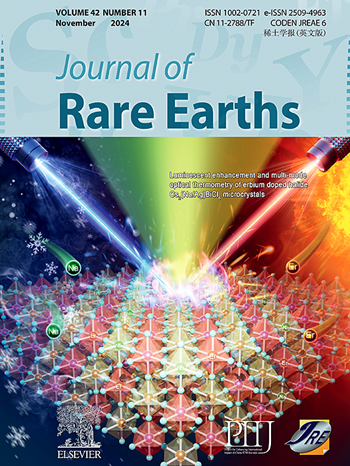Ligand rigidity-mediated coordination symmetry engineering in lanthanide-titanium nanoclusters achieves >90% photoluminescence quantum yield
IF 7.2
1区 化学
Q1 CHEMISTRY, APPLIED
引用次数: 0
Abstract
Achieving high-efficiency photoluminescence in trivalent lanthanides (Ln3+) requires precise crystal-field perturbation to overcome parity-forbidden 4f-transitions and suppress nonradiative decay. However, realizing such control remains challenging, even in well-optimized Ln3+-doped nanocrystals. Here, by exploiting the atomically precise structure of metal nanoclusters, we demonstrate symmetry engineering in the Eu2Ti4 nanoclusters through stepwise ligand substitution (BA/Phen → FBA/Phen→ FBA/Bpy. BA: benzoicacid; Phen: 1,10-phenanthroline; FBA: p-fluorobenzoicacid; Bpy: 2,2′-bipyridine). The incorporation of FBA effectively suppresses nonradiative relaxation, while the flexible Bpy ligand induces symmetry reduction from D2d to C2v through coordination modulation, yielding a high photoluminescence quantum yield (PLQY) of 91.2% in the Ln3+ cluster systems. The transient-absorption, Judd-Ofelt theory, crystal-field analysis, and temperature-dependent photophysical studies elucidated the underlying modulation mechanisms. Furthermore, these clusters exhibit promising potential for optoelectronic applications, offering a new design strategy for high-performance luminescent materials.

配体刚性介导的配位对称工程在镧钛纳米团簇中实现了90%的光致发光量子产率
在三价镧系元素(Ln3+)中实现高效光致发光需要精确的晶体场扰动来克服奇偶禁止的4f跃迁和抑制非辐射衰变。然而,即使在优化的Ln3+掺杂纳米晶体中,实现这种控制仍然具有挑战性。本文利用金属纳米团簇的原子精确结构,通过逐步取代配体(BA/Phen→FBA/Phen→FBA/Bpy),证明了Eu2Ti4纳米团簇的对称性工程。英航:benzoicacid;苯酚的:1、10-phenanthroline;FBA: p-fluorobenzoicacid;Bpy: 2, 2’关于环)。FBA的加入有效地抑制了非辐射弛豫,而灵活的Bpy配体通过配位调制诱导从D2d到C2v的对称性还原,在Ln3+簇体系中产生了91.2%的高光致发光量子产率(PLQY)。瞬态吸收、Judd-Ofelt理论、晶体场分析和温度依赖性光物理研究阐明了潜在的调制机制。此外,这些团簇在光电应用方面表现出良好的潜力,为高性能发光材料的设计提供了新的策略。
本文章由计算机程序翻译,如有差异,请以英文原文为准。
求助全文
约1分钟内获得全文
求助全文
来源期刊

Journal of Rare Earths
化学-应用化学
CiteScore
8.70
自引率
14.30%
发文量
374
审稿时长
1.7 months
期刊介绍:
The Journal of Rare Earths reports studies on the 17 rare earth elements. It is a unique English-language learned journal that publishes works on various aspects of basic theory and applied science in the field of rare earths (RE). The journal accepts original high-quality original research papers and review articles with inventive content, and complete experimental data. It represents high academic standards and new progress in the RE field. Due to the advantage of abundant RE resources of China, the research on RE develops very actively, and papers on the latest progress in this field emerge every year. It is not only an important resource in which technicians publish and obtain their latest research results on RE, but also an important way of reflecting the updated progress in RE research field.
The Journal of Rare Earths covers all research and application of RE rare earths including spectroscopy, luminescence and phosphors, rare earth catalysis, magnetism and magnetic materials, advanced rare earth materials, RE chemistry & hydrometallurgy, RE metallography & pyrometallurgy, RE new materials, RE solid state physics & solid state chemistry, rare earth applications, RE analysis & test, RE geology & ore dressing, etc.
 求助内容:
求助内容: 应助结果提醒方式:
应助结果提醒方式:


